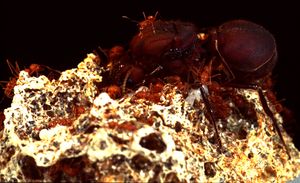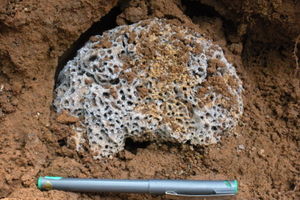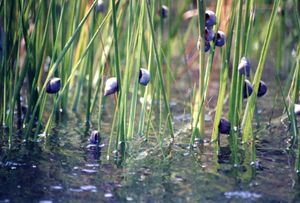Fungal farming: Difference between revisions
No edit summary |
No edit summary |
||
| Line 51: | Line 51: | ||
The Periwinkle snail, ''Littoraria irrorata'', is the first observed example of fungal farming that is not associated with terrestrial systems or insects. This snail is a grazer that is typically found on marsh cordgrasses, such as ''Spartina alterniflora'' (Silliman and Newell, 2003). While it was previously though that these snails were detritivores, researchers discovered that the snail is an active grazer of these grasses (Silliman and Newell, 2003). This grazing is a key part of the fungal farming process. | The Periwinkle snail, ''Littoraria irrorata'', is the first observed example of fungal farming that is not associated with terrestrial systems or insects. This snail is a grazer that is typically found on marsh cordgrasses, such as ''Spartina alterniflora'' (Silliman and Newell, 2003). While it was previously though that these snails were detritivores, researchers discovered that the snail is an active grazer of these grasses (Silliman and Newell, 2003). This grazing is a key part of the fungal farming process. | ||
[[File:Marsh_periwinkle_001.jpg|thumb|''Littoraria irrorata'' on marsh grasses where their fungal farms are located]] | |||
The first step in the farming process of these snails is preparing the substrate. To prepare the substrate the snail uses its radulae to cut openings in the leaf surface. This activity is mainly to promote the growth of fungi because the snails do not feed on the cut plant material (Silliman and Newell, 2003). The wounds expose the inner plant material which is a nutritious food source for ascomycete fungi and these fungi populate around these wounds. To increase the success of their farming efforts, the snail will deposit fecal pellets that are rich in nitrogen and hyphae onto the open wounds where the fungi have invaded (Silliman and Newell, 2003). These fecal pellets act as a fertilizer for the fungi and may also increase propagules due to the hyphae, although it is unknown whether the hyphae are vital (Silliman and Newell, 2003). Some unique aspects of the fungal farming process of these snails is that they do not inoculate their crop or weed out unwanted invaders (Silliman and Newell, 2003). The spores of these fungi are rather abundant in the system so snails do not need to find spores because they already present (Silliman and Newell, 2003). Even though the fungi are the preferred food of the snails, this relationship is facultative for both species (Silliman and Newell, 2003). | The first step in the farming process of these snails is preparing the substrate. To prepare the substrate the snail uses its radulae to cut openings in the leaf surface. This activity is mainly to promote the growth of fungi because the snails do not feed on the cut plant material (Silliman and Newell, 2003). The wounds expose the inner plant material which is a nutritious food source for ascomycete fungi and these fungi populate around these wounds. To increase the success of their farming efforts, the snail will deposit fecal pellets that are rich in nitrogen and hyphae onto the open wounds where the fungi have invaded (Silliman and Newell, 2003). These fecal pellets act as a fertilizer for the fungi and may also increase propagules due to the hyphae, although it is unknown whether the hyphae are vital (Silliman and Newell, 2003). Some unique aspects of the fungal farming process of these snails is that they do not inoculate their crop or weed out unwanted invaders (Silliman and Newell, 2003). The spores of these fungi are rather abundant in the system so snails do not need to find spores because they already present (Silliman and Newell, 2003). Even though the fungi are the preferred food of the snails, this relationship is facultative for both species (Silliman and Newell, 2003). | ||
Revision as of 19:45, 9 April 2021
Fungus farming is a form of symbiosis between fungi and fungi-growing organism in which a species facilitates the growth of a fungal species in order to create a stable food supply. This mutualistic behavior is an example of how two species can co-evolve over time through interactions that are mutually beneficial(Silliman and Newell, 2003). These relationships are typically obligate because both species could not survive without the other.
Fungus farming is thought to have originated some 30-60 million years ago and evolved in three different insects, specifically ants, beetles, and (Mueller and Gerardo, 2002). While it was previously thought that this behavior was only found in insects, recent findings have uncovered a snail that farms fungus.
Farming Process
Similar to human agriculture, fungus farmers must go through a process to prepare and care for their crops. In order to culture fungi, farmers must prepare the substrate and inoculate their crop in prime growing conditions. Growers must also tend to their crop as it grows to ensure the success of the crop. Tending to crops can be in the form of fertilization or as protection from competition, pests, and pathogens. Once the crop is fully grown the farmers can harvest and consume the fungi. (Silliman and Newell, 2003; Wang et al., 2015). Subsisting on farmed fungus over time creates a nutritional dependency (Mueller and Gerardo, 2002). Fungus farming relationships are obligate mutualisms because both the fungus and farmer rely on each other due to generations of the dependency (Toki et al., 2012).
The exact process a fungus farmer goes through to cultivate their crop can vary among species of farmers, as well as species of fungi. Fungus cultivation can be characterized as either high-level food production or low-level food production (Rehner, 2005). Low-level food production consists of altering the environment to promote or protect the fungus. High-level fungus production involves more complicated steps such as transporting and planting the fungus, fertilization, and protecting the crops physically or chemically (Rehner, 2005; Wang et al., 2015).
Terrestrial Systems
The majority of fungus farming mutualisms are found in terrestrial systems because this relationship evolved in 3 distinct insect lineages, ants(Formicidae), termites(Isoptera), and beetles(Coleoptera). These mutualisms evolved independently in each of the 3 insects (Mueller and Gerardo, 2002) resulting in unique farming practices between the various farmers.
Ants
Fungus-growing ants are a monophyletic group that is a part of the Formicidae family and grouped together into a tribe known as Attina. Attine ants are thought to have originated around 40-60 million years ago in the tropical forests of South America (Branstetter et al., 2017; Muller et al., 2001). Currently there are more than 200 known species of attine ants, including the well-known leaf-cutter ants, and they are all found in the western hemisphere, in tropical rainforests (Rehner, 2005). It is currently unknown how these farming relationships started, but there have been 2 models put forward to try and explain its origins (Muller et al., 2001). The “consumption first” model states that the cultured fungi began as part of the ant’s diet and overtime the ants started to grow the fungi which then lead to the transferring and spread of the crop (Muller et al., 2001). The opposing model is called the “transmission first” model which states the fungi could have been dispersed by the ants before they became part of their diet (Muller et al., 2001).
The farming process begins when a young female leaves the mother colony to find her own. The founding ant brings with her some fugus from the parent colony to start the farm for the new colony. The farms are grown in enclosed, often subterranean burrows and the ants must collect some type of growth material and substrate to propagate their crop. Most attine farmers grow Basidiomycota fungi, with a majority of fungi belonging to the Leucocoprinus genus (Mehdiabadi and Schultz, 2009). While the crops grow the ants must tend to their crop and this can include fertilization with organic and fecal material or weeding of unwanted invaders or predators (Silliman and Newell, 2003). While the general process of fungal farming is relatively similar between different species of attine ants, there are some unique differences. Throughout the history of the fungus farming ants there have been five agriculture systems that have been observed. The five agriculture systems of attine ants are 1) Lower agriculture, 2) Coral-fungal agriculture, 3) Yeast agriculture, 4) Generalized higher agriculture, and 5) Leafcutter agriculture (Mehdiabadi and Schultz, 2009).
Lower agriculture refers to the simplest and oldest form of fungal farming. Ants belonging to this system culture Leucocoprinus fungi and employ a number of different substrate types including bits of grasses, fruit flesh, seeds, insect waste, wood, flower parts, and other organic materials (Mehdiabadi and Schultz, 2009).
Coral-fungal agriculture differs from the other systems because this agricultural system grows Pterulaceae fungi instead of fungi belonging to the Leucocoprineae. This system is poorly studied but some of the substrates that have been found are insect frass, seeds, detritus material, wood, and even arthropod parts (Mehdiabadi and Schultz, 2009).
Yeast agriculture is where the attine ants grow yeats-like fungi that are closely related to Leucocoprineae. In this system the fungi are grown as unicellular nodules rather than a multicellular phase (Mehdiabadi and Schultz, 2009). The substrate that is typically used for this system is arthropod waste, but there have been some species that reguritate nectar and sap onto the crops to promote its growth. (Mehdiabadi and Schultz, 2009).
Generalized higher agriculutre is characterized by domesticated fungi that are not considered free-living. These domesticated fungi prodcue nutrient righ hyphal tips, called “gongylidia” (Mehdiabadi and Schultz, 2009). Ants that utlize this system use similar substrates as the previous systems, but also collect live and fresh plant matter to use as substrate, such as plant shoots, flower petals, and leaves(Mehdiabadi and Schultz, 2009).
Leafcutter agriculture is the final and most complex system of fungus farming. This system differs from generalized higher agriculutre mainly because leafcutter agriculutre primarily use cut plant matreial as growth substrate (Mehdiabadi and Schultz, 2009). The well-known Leafcutter ants belong to this agriculutre system, hence the name. Leafcutter ants not only physically cut plant material from living plants for substrate use, but also tend to their crop by weeding out unwanted microfungi (Rodrigues et al., 2008).
Termites
Around the same time ants began to develop their mutualistic relationships with fungus, termites were also developing their own farming techniques. Fungus-growing termites, Macrotermitinae, belong to the Termitidae family and are thought to have originated around 30 million years ago in African rainforest (Aanen and Eggleton, 2005). Today there are around 300 species of termites that cultivate fungi and they can be found throughout Africa, Asia, and Europe (Mueller and Gerardo, 2002). A defining characteristic of Macrotermitinae are the complex mounds that these termites make that house the termites and the fungus farms. Inside of these mounds there are specialized burrows that are known as combs that are used to cultivate their fungi.(Mueller and Gerardo, 2002).
Once the comb burrow has been dug out the termites prepare the combs by depositing feces. The feces is nutrient rich and mixed with semi-digested plant material such as leaves, grass, and wood (Mueller and Gerardo, 2002). The termites grow a specific fungus known as Termitomyces, which belong to the Basidiomycota. These fungi can survive the digestion of the termites when consumed and this allows the termites to deposit both the fungal spores and fecal matter together in the combs (Mueller and Gerardo, 2002). Depositing the spores and feces allows the termites to plant their crop but also fertilize it at the same time. Unlike the attine ants, the fungi planted by termites grow until they form fruiting bodies and spores. (Aanen et al., 2002). The farmers then harvest and consume the fungi, but since the spores can survive the gut of the termite the cycle can continue.
Beetles
Beetles are a type of insect that make up the Coleoptera and include some beetles that have been found to cultivate fungi. The beetles that are found to grow fungi are considered weevils, a subfamily of Coleopterans. These beetles create burrows in host trees and the fungal farms are found inside some of these burrows. This symbiosis between beetles and fungi are thought to have originated around 60 million years ago (Farrell et al., 2001). Fungal farming in ants and termites evolved only once but this mutualism is believed to have evolved at least 7 times in beetles (Silliman and Newell, 2003). Beetles that engage in fungus faming are known as Ambrosia beetles because they found to exclusively grow ambrosia fungi (Hulcr et al., 2015). Presently there are over 3000 known beetles that farm fungus and majority of them are found in tropical forests, there are a few species that are found in temperate systems (Farrell et al., 2001). The reason for the greater abundance of fungal farming beetles in the tropics is because temperate habitats are typically drier and may not have enough moisture to support fungal cultivation (Farrell et al., 2001).
To begin the farming process the beetles will burrow into living, and sometimes dead, trees and create elaborate tunnels. Once the tunnels are complete the beetles can start to inoculate their crop. Beetles employ a unique method to acquire their crops. The beetles have a morphological structure known as a “mycangia” which is simply a pocket on the beetle that is specifically used to transport fungi (Farrell et al., 2001). Using their mycangia, beetles collect fungus spores and bring them back to the host tree which harbors the beetle colony and begin to plant their crop (Farrell et al., 2001). The fungi are planted within the walls of the tunnels and left to grow into the host plants xylem and phloem, which further promotes their growth (Farrell et al., 2001). Once the crop grows to maturity the fungus will form a layer of hyphae on the walls of the burrow known as “ambrosia” (Beaver, 1989). Both adult and larvae feed on these fungi and when it is time for a beetle to leave the colony it will bring spores with it in its mycangia to ensure the success of the future farm.
Aquatic Systems
While the majority of fungus farmers are found in terrestrial systems that does not mean that fungus farming is exclusive to those systems. A study in 2003 found the first evidence of fungal farming in an aquatic system and outside of the insect family.
Marine snail
The Periwinkle snail, Littoraria irrorata, is the first observed example of fungal farming that is not associated with terrestrial systems or insects. This snail is a grazer that is typically found on marsh cordgrasses, such as Spartina alterniflora (Silliman and Newell, 2003). While it was previously though that these snails were detritivores, researchers discovered that the snail is an active grazer of these grasses (Silliman and Newell, 2003). This grazing is a key part of the fungal farming process.
The first step in the farming process of these snails is preparing the substrate. To prepare the substrate the snail uses its radulae to cut openings in the leaf surface. This activity is mainly to promote the growth of fungi because the snails do not feed on the cut plant material (Silliman and Newell, 2003). The wounds expose the inner plant material which is a nutritious food source for ascomycete fungi and these fungi populate around these wounds. To increase the success of their farming efforts, the snail will deposit fecal pellets that are rich in nitrogen and hyphae onto the open wounds where the fungi have invaded (Silliman and Newell, 2003). These fecal pellets act as a fertilizer for the fungi and may also increase propagules due to the hyphae, although it is unknown whether the hyphae are vital (Silliman and Newell, 2003). Some unique aspects of the fungal farming process of these snails is that they do not inoculate their crop or weed out unwanted invaders (Silliman and Newell, 2003). The spores of these fungi are rather abundant in the system so snails do not need to find spores because they already present (Silliman and Newell, 2003). Even though the fungi are the preferred food of the snails, this relationship is facultative for both species (Silliman and Newell, 2003).



